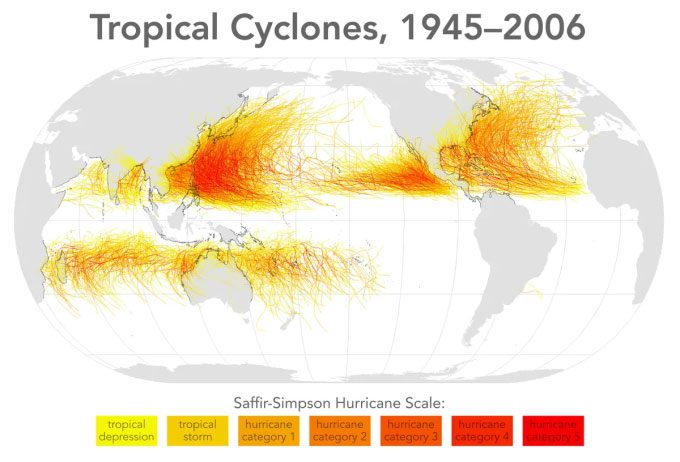Storms on Earth rarely approach the equator, and intriguingly, they never cross this boundary.

Tropical storms from 1945 to 2006 avoid the equator. (Photo: Wikimedia).
Storms function like a giant spinning turbine that draws energy from warm, moist air. They tend to form over tropical sea areas where the water temperature exceeds 26 degrees Celsius. The warm water heats the air above it, causing it to rise and cool, forming clouds and thunderstorms. This rising air also creates a low-pressure area below, pulling in more air.
With the assistance of winds, these conditions can lead to the formation of a storm. Eventually, the clouds above release rain and heat down to the surface, continuing to fuel the storm below.
The direction of winds and the rotation of storms are determined by the Coriolis force – the inertial force acting on an object due to the Earth’s rotation. In the Northern Hemisphere, the Earth’s spin causes air to be pulled counterclockwise, resulting in storms also rotating counterclockwise. In the Southern Hemisphere, the opposite occurs, leading storms to spin clockwise.
Despite raging over warm tropical waters, storms rarely form within 300 kilometers of the equator. In 2003, Storm Vamei operated just 150 kilometers north of the equator, but this was truly an exception, with an occurrence rate of less than once per century.
Storms do not appear near the equator because there is no Coriolis effect here, which means weather systems do not tend to “rotate” into storms. Similarly, storms do not cross the equator because that would require them to stop rotating, reverse direction, and spin the other way to continue functioning.
Theoretically, a “well-developed storm” could be strong enough to maintain its rotation, overcoming the relatively weak Coriolis force and reach the equator, according to Gary Barnes, a meteorology professor at the University of Hawaii. However, Barnes and other experts note that they have never encountered a real-life example of this case.


















































